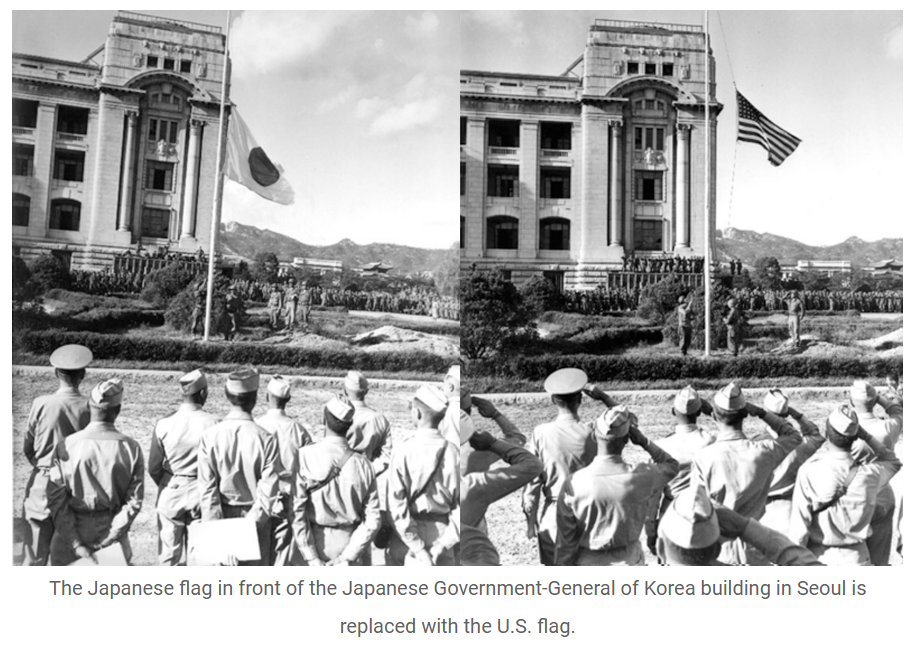United States Army Military Government in Korea: Difference between revisions
More languages
More actions
Verda.Majo (talk | contribs) (adding more information and sources) Tag: Visual edit |
General-KJ (talk | contribs) No edit summary |
||
| Line 10: | Line 10: | ||
== References == | == References == | ||
<references /> | <references /> | ||
[[Category:History of Korea]] | |||
Latest revision as of 19:26, 22 November 2024

The United States Army Military Government in Korea (USAMGIK) was the United States' occupying authority in the southern part of Korea from September 8, 1945 until August 15, 1948.[2]
Prior to the arrival of U.S. forces in Korea, Koreans had established various organizations for self-government, such as numerous People's Committees throughout the country as well as declaring the short-lived People's Republic of Korea (PRK). These forms of self-government had grown out of Korea's independence struggle, and were able to come out into the open and further expand after imperial Japan's defeat. However, USAMGIK did not recognize the authority of the PRK nor the People's Committees and proceeded to outlaw and dismantle them, and created new local councils under conservative control[3] as well as rehired officers from the Japanese colonial era.[4][5]
Richard D. Robinson, a historian[6] who at the time of USAMGIK's occupation was the chief of the Public Opinion Section of the Department of Information of the USAMGIK,[7] has been quoted describing the occupation as "incredibly bungled by an incompetent and corrupt administration"[8] and has further been quoted describing the situation as follows:
It was safe to say that for the most part the local People's Committees in these early days were of the genuine grassroots democratic variety and represented a spontaneous urge of the people to govern themselves. [...] They resented orders from the Military Government to turn the administration of local government over to American Army officers and their appointed Korean counterparts, many of whom were considered to be Japanese collaborators. It seemed like a reversion to what had gone before. Bloodshed ensued in many communities as local People's Committees defied the Military Government and refused to abandon government offices. Koreans and Americans met in pitched battles, and not a few Koreans met violent death in the struggle.[7]
Ahn Hak-sop, a former officer in the Korean People's Army who was captured in 1952 and endured decades of torture as a political prisoner in south Korea, spoke about the USAMGIK's occupation in a 2019 interview with Liberation School:
In September of 1945, Koreans went out to greet the US Army, but the US Army shot at them. After the Moscow Committee, the US Army said explicitly that they were there to block the Soviet Union. But in 1948, the Soviet Union withdrew all of their troops. But the US Army didn’t withdraw. In almost every town, there was a People’s Committee for self-rule, but the US Army crushed the People’s Committees with tanks and soldiers.[9]
The "Jeju 4•3 Incident Investigation Report" published in 2003 by south Korea's government assigns responsibility for the Jeju massacre not only to dictator Syngman Rhee but also to the USAMGIK authorities.[2][10]
References[edit | edit source]
- ↑ "Liberation from Japan in 1945." Jeju 4.3 Peace Foundation. Archived 2023-06-04.
- ↑ 2.0 2.1 Heo Ho-joon. "‘My mission is suppression’: Jeju blood on the hands of the US military government." Hankyoreh, 2023-04-04. Archived 2024-03-16.
- ↑ Kim Jinwung. "A Policy of Amateurism: The Rice Policy of the U.S. Army Military. Government in Korea, 1945-1948." Korea Journal, Summer 2007. (PDF)
- ↑ "Who ruled over the Korean Peninsula?" Jeju 4.3 Peace Foundation. Archived 2023-03-30.
- ↑ “For example, the U.S. military government decided to utilize former colonial police officers, who served the interests of the Japanese colonial regime, to deal with the shortage of police-trained manpower and to manage postcolonial social instability (Meade, 1951). Out of 25,000 police officials in 1946, more than a half of the officers were former colonial officers. Due to the organizational and behavioral similarities between the colonial and postcolonial police, the populace’s deep-seated hatred toward colonial police remained intact.”
Wonhyuk Cho (2017). Change and Continuity in Police Organizations: Institution, Legitimacy, and Democratization., vol. Vol. 32, No. 1 (2017), pp. 149-174.. [PDF] The Korean Journal of Policy Studies, GSPA, Seoul National University. - ↑ "AIB Fellow - Richard D. Robinson." Academy of International Business (AIB). September 2009. Archived 2024-03-17.
- ↑ 7.0 7.1 Robinson, Richard. Cited in Mark J. Scher (1973) "U.S. policy in Korea 1945–1948: A Neocolonial model takes shape." Bulletin of Concerned Asian Scholars, 5:4, 17-27, DOI: 10.1080/14672715.1973.10406346. https://doi.org/10.1080/14672715.1973.1040634
- ↑ Robinson, Richard. Cited in Chung, Yong Wook. "From Occupation to War; Cold War Legacies of US Army Historical Studies of the Occupation and Korean War." Korea Journal, vol. 60, no. 2 (summer 2020): 14–54. doi: 10.25024/kj.2020.60.2.14 © The Academy of Korean Studies, 2020.
- ↑ Ahn Hak-sop, Derek Ford. "Still fighting for Korea’s liberation: An interview with Ahn Hak-sop." Liberation School, 2023-07-27. Archived 2024-01-17.
- ↑ "The Jeju 4·3 Incident Investigation Report." The National Committee for Investigation of the Truth about the Jeju April 3 Incident, Jeju 4·3 Peace Foundation, 2003.
